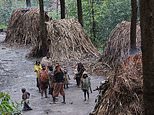
We drive.
Robert steers the jeep down a bright orange, dusty track.
To our left is a steep incline with tree roots tangled in the soil. To our right, a sheer drop.
‘Don’t look down,’ he says with a laugh.
When we finally emerge from the winding mountain pass of Bwindi Impenetrable Forest, we are greeted with familiar scenes of people selling local fresh produce at the roadside. As we reach the other end of the village, however, things take an unexpected turn.
MailOnline Travel’s Laura Sharman is introduced to Pygmies in Uganda, where they are known as the Batwa. Above is a picture she takes of the tribe she is introduced to
‘The Pygmies are our neighbours,’ says Robert, our driver, who has stopped off here at his village on our journey back to the lodge.
‘They live here at the edge of the forest.’
I look down into a dark clearing and see several people resting against a pile of maize bags and two children watching on with curious eyes from a nearby treehouse.
The Pygmies, known as the Batwa here in Uganda, are indigenous inhabitants of this mountainous region which is famed for its gorilla trekking.
Anthropologists believe that for 60,000 years, the hunter-gatherer tribe ‘thrived in harmony’ with the wildlife in the depths of the forest, earning them the reputation as its ‘keepers’, according to the Bwindi Forest National Park website.
However, government efforts to protect its endangered gorilla population, among other animals, saw the Batwa evicted from their homes when the forest was named a national park in 1991.
Tucked away in this remote corner of south-western Uganda, these people are now conservation refugees.
The Batwa are indigenous inhabitants of Bwindi Impenetrable Forest, famed for its gorilla trekking
The Batwa have a tradition of building treehouse (above) to offer their children protection from predators
I ponder the complexities of this situation and look again at the maize bags, an elderly man propped up against them.
‘The Batwa used to hunt small animals for meat,’ Robert says, ‘when they lived very deep in the forest. And they built treehouses like this one to keep their children high up, away from predators when they went looking for food. Meat, yes, but also fish, honey, fruits, berries.
‘The men used spears or bows and arrows to catch bush pigs, monkeys, birds, and the women looked for fruits and honey. Now they are relying on food donations.’
He explains that they are the world’s shortest tribe, with adults growing no taller than 4ft 9in (150cm) on average.
Britannica concurs.
We enter the clearing and Robert introduces me to the elderly gentleman leaning against the maize bags, translating between English and Rutwa.
‘He says this is their home now,’ says Robert.
Feeling a little uncomfortable, I follow Robert’s finger as he points to some straw huts and then at the children in the treehouse, made from grass and branches. ‘Shall we walk?’ I suggest, not wanting to impose upon this family with what I sense is about to become a tour.
We follow another bend in the road,which opens out to views of graduated terrace steps and the dense forest below.
Laura’s meeting with the Batwa comes as she’s driven back to her lodge (above)
Laura encounters mountain gorillas, some of which she captures in this photo, under the guidance of park rangers in Bwindi Impenetrable Forest
The Batwa were evicted from their forest homes to protect the endangered mountain gorilla population. ‘The gorillas are what brought me to this magical corner of the world but I leave with my mind focused on the Batwa,’ Laura writes
Anthropologists believe that for 60,000 years, the Batwa tribe ‘thrived in harmony’ with the wildlife in the depths of Bwindi Impenetrable Forest
Only a few hours ago, we were scrambling down its slopes made impenetrable – I discovered – not only by their steepness but also by endless thorn bushes.
Why? To encounter the mountain gorillas of course, under the guidance of park rangers.
Now, standing here on the mountaintop, the park looks like a soothing bed of vegetation. And I spare a thought for Uganda’s forgotten tribe.
‘All this used to belong to the Batwa,’ says Robert. ‘Don’t forget them.’
Bwindi Impenetrable Forest is made impenetrable, Laura writes, not only by its steepness but also by its endless thorn bushes, as this picture shows
Laura snaps this image from the back of the jeep as she returns from her gorilla trek
Laura in Bwindi Impenetrable Forest
Pygmies, including the Batwa, are thought to have been the first people to live in this stretch of forest which covers not only parts of Uganda but also Burundi, the Democratic Republic of Congo and Rwanda, according to Britannica.
As more people moved into the area, cutting down trees to make way for crops and livestock, the Batwa people were limited to smaller areas and continued their way of life.
But they never sought to own the land they lived on so they were not considered eligible for compensation when they were evicted.
Today, around 6,700 Batwa live in south-western Uganda according to a 2023 report by the International Work Group for Indigenous Affairs, a global human rights organisation that ‘promotes and defends indigenous people’s rights’.
The gorillas are what brought me to this magical corner of the world but I leave with my mind focused on the Batwa. For 60,000 years they shared the forest.
‘Don’t forget,’ I remember.
Source link
CHECK OUT: Top Travel Destinations
READ MORE: Travel News



